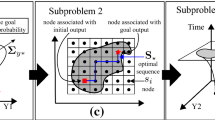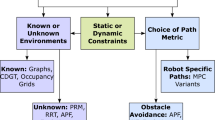Abstract
The reachability of a robot manipulator to a target is defined as its ability to move its joints and links in free space in order for its hand to reach the given target. This paper presents a way of testing the reachability of a robot to given target. The target could be a three dimensional object represented by a cuboid, a line or merely a point.
The reachability test problem is transformed into a nonlinear optimization problem, which is solved by using the Tunneling Algorithm [1–3].
The paradigm of the Tunneling Algorithm is described in detail. Several examples of testing the reachability of two robots to given targets are presented and the results are compared with that of the existing RGRG algorithm [5]. The results of comparisons show that the Tunneling Algorithm is better than the RGRG algorithm. It can always obtain the correct answers of testing, and it is effective and suitable to solve the reachability test problem.
Similar content being viewed by others
References
Levy, A. V. and Gomez, S.: The tunneling method applies to global optimization,Numerical Optimization (1984).
Levy, A. V., Montalvo, A., Gomez, S., and Calderon, A.: Topics in global optimization,Lecture Notes in Mathematics 909, 1982.
Levy, A. V. and Montalvo, A.: A modification to the tunneling algorithm for finding the global minima of an arbitrary one dimensional function, Communications Tecnicas, Serie Naranja, No. 240, IIMAS-UNAM, 1980.
Scales L. E.,Introduction to Non-Linear Optimization, Springer-Verlag, New York, 1985.
Ying Z., Xi, Y. and Zhang Z., Test of the reachability of a robot to an object,Proc. IEEE Int. Conf. on Robotics and Automation, 1989, pp. 490–494.
Tsai Y. C. and Soni A. H. Accessible region and synthesis of robot arms,ASME J. Mech. Design 103 (1981), 803–811.
Lee T. W. and Yang D. C. H. On the evaluation of manipulator workspace,ASME J. Mech. Trans. Autom. Des. 105 (1983), 70–77.
Yang D. C. H. and Lee T. W.: On the workspace of mechanical manipulators,ASME J. Mech. Trans. Autom. Des. 105 (1983), 62–69
Sugimoto K. and Duffy J., Determination of extreme distance of a robot hand — part 1: A general theory,ASME J. Mech. Design 103 (1981), 631–636.
Rastegar J. and Deravi P., Methods to determine workspace, its subspaces with different numbers of configurations and all possible configurations of a manipulator,Mech. Mach. Theory 22 (1987), 343–350.
Ming-shu Hsu and Kohli D., Boundary surfaces and accessibility regions for regional structures of manipulators,Mech. Mach. Theory 22(3) (1987), 227–289.
Paul R. P.,Robot Manipulators: Mathematics, Programming and Control, MIT Press, 1981.
Zone-Chang Lai and CHia-Hsuoang Menq, The dexterous workspace of simple manipulators,IEEE Journal of Robotics and Automation 4(1) (1988).
Author information
Authors and Affiliations
Additional information
This project is partially supported by a grant from Martin Marietta (ORNL) 19x-55902V. Also this project is partially funded by ONR grant N00014-94-1-0343.
Rights and permissions
About this article
Cite this article
Ying, Z., Iyengar, S.S. Robot reachability problem: A nonlinear optimization approach. J Intell Robot Syst 12, 87–100 (1995). https://doi.org/10.1007/BF01258308
Received:
Accepted:
Issue Date:
DOI: https://doi.org/10.1007/BF01258308




